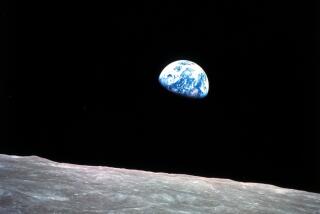Shuttle Flies, and a Dad Breathes Again
- Share via
There was an audible sigh of relief in our family room the morning that the space shuttle Discovery at last thundered into the heavens.
My daughter was snuggled in her mother’s arms as Discovery completed a picture-perfect launch. From her perch, Margot couldn’t help but notice the goose bumps that rose on my wife’s arms when NASA gave Discovery permission to “throttle up.”
This parent was tremendously relieved by that successful launch. For the previous week, Margot, who is nearly 5, had been asking for permission to watch the shuttle lift off.
To her, the situation was simple. She wanted to “watch the astronauts go up into space.” In pre-Challenger times, her father would have granted that simple request without hesitation. And, instead of Captain Kangaroo, Margot and her 6-year-old brother, Tim, would have watched the astronauts.
After all, Americans--my wife and I included--have been watching astronauts go into space for almost as long as we’ve been watching the Captain.
But this time I hesitated before granting permission.
Part of the dilemma was solved when NASA delayed the launch. Tim’s school bus--on Thursday morning we dubbed it the “yellow shuttle”--arrives at 7:20 a.m., so he was in kindergarten when Discovery took off.
I was hoping the delay might postpone the launch until after Margot was on her way to preschool.
My concern was that Discovery--like Challenger--would explode, killing or injuring the astronauts, whom my daughter idolizes. It seems to me that raising children is complicated enough without adding a televised disaster.
I know the Challenger incident was not the norm and that our nation’s space program has been unusually blessed. It faltered on occasion--three astronauts did perish during a training exercise in Texas in the 1960s--but, when it came to the real thing, our rockets always worked and our astronauts always came back alive.
In days gone by, I had watched those space shots with the thought that I might one day join the select few who escape Earth’s gravity. That dream waned as I grew older, and I’m now content with an occasional airplane ride.
But I want my children to enjoy the thrill of watching a magnificent flying machine carry explorers into space. And I suspect that Margot already harbors dreams of one day exploring the stars.
But I still have strong memories of the television pictures that were beamed from teacher/astronaut Christa McAuliffe’s New Hampshire classroom in 1986. I still remember her befuddled students, who were gathered before television sets, as they tried to understand a tragedy that even adults were at first unable to comprehend.
The glorious space shuttle had disappeared in a faraway puff of smoke, along with seven men and women.
I didn’t want my children in front of the television Thursday morning, in part, because I didn’t know how I would explain the possible death and destruction should something go awry.
I’m sure that many parents across the country had to wrestle with the same question: Should children be able to watch history in the making or be sheltered in case something goes wrong?
I’ve never asked my parents if they had the same qualms as we watched the original seven astronauts take their first small steps into space.
I’d guess that my parents were just as awed as I was, and as my children are. The launch went smoothly--but my question was not really answered, because a few hours later Margot announced that in just a few days she would get to watch the astronauts come back to Earth. Until she gets older, I’ll probably be asking the same questions every time man heads into space.
Luckily, she’s oblivious to my worries. During the recent full moon, Margot looked up into the heavens and then at me. “Do you think there are astronauts up there now, Dad?” she asked.
I thought back to the cool Ohio nights when I, too, had searched the heavens for similar signs of life. “They’ll be up there pretty soon,” I said.
More to Read
Sign up for Essential California
The most important California stories and recommendations in your inbox every morning.
You may occasionally receive promotional content from the Los Angeles Times.













